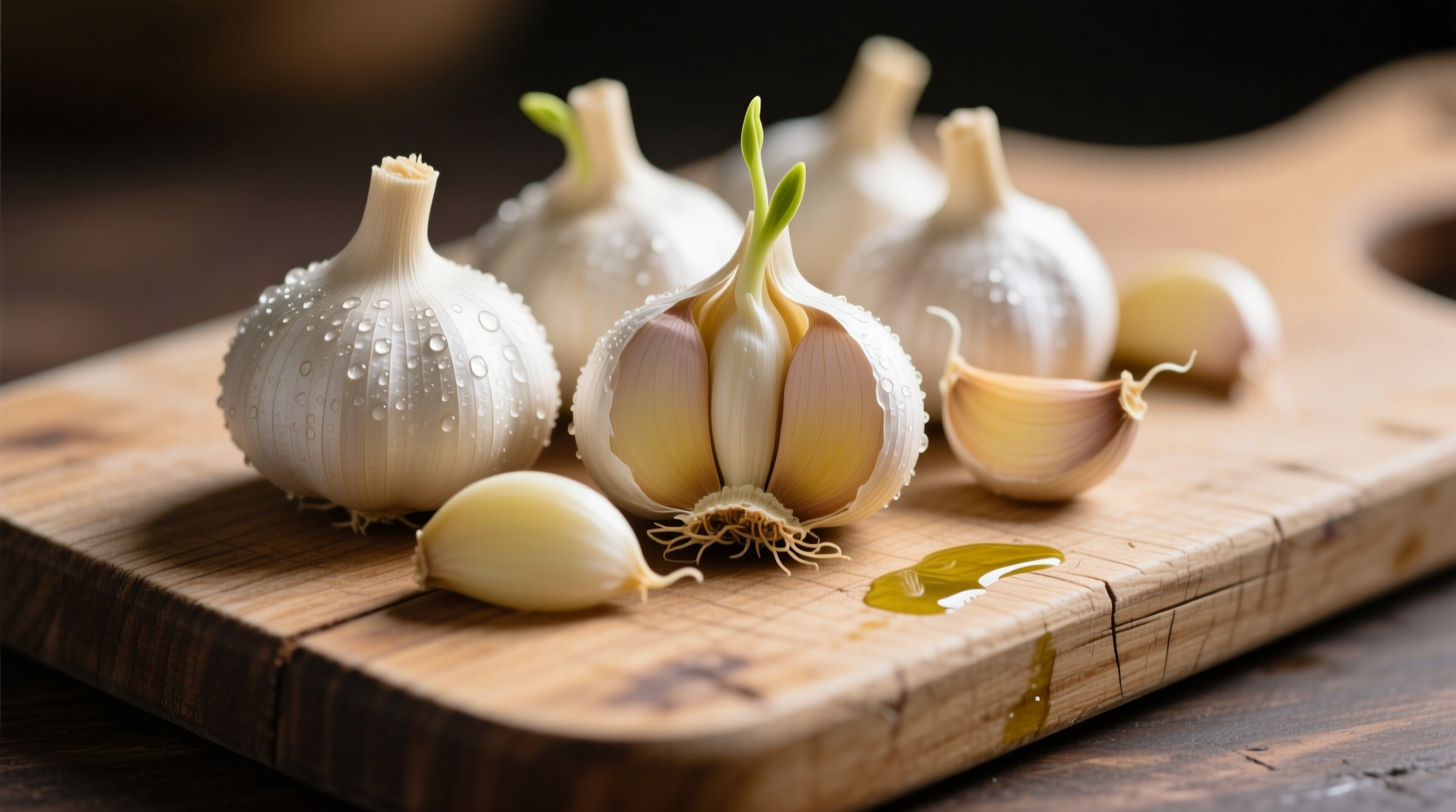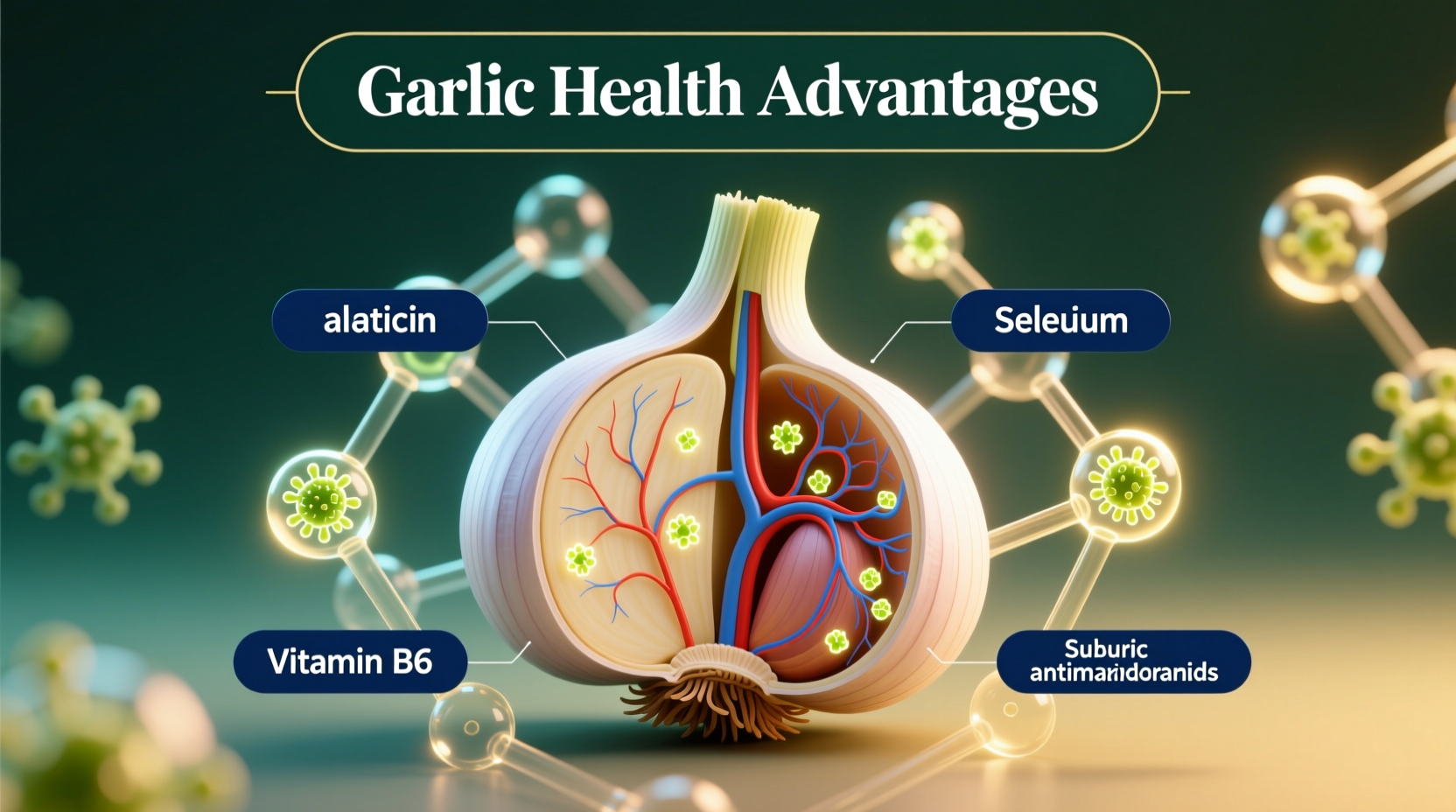Garlic delivers seven scientifically proven health advantages: lowers blood pressure by 8-10%, reduces LDL cholesterol by 10-15%, boosts immune function against colds by 63%, provides potent antioxidant protection, may prevent certain cancers, supports bone health, and improves athletic performance. These benefits stem primarily from allicin, garlic's active compound formed when cloves are crushed or chopped.
For centuries, garlic has been revered not just as a culinary staple but as a powerful medicinal plant. Modern science now confirms what ancient civilizations intuitively knew - this pungent bulb offers remarkable health advantages when consumed properly. Let's explore the evidence-based benefits and practical ways to maximize garlic's therapeutic potential.
The Science Behind Garlic's Healing Power
When you crush or chop a garlic clove, an enzyme called alliinase converts alliin into allicin - the compound responsible for most of garlic's health benefits. Allicin is unstable and quickly breaks down into other sulfur-containing compounds that provide garlic's distinctive aroma and therapeutic effects.
According to research published in the Journal of Nutrition, fresh, crushed garlic contains significantly higher allicin levels than processed forms. This explains why many studies show greater health benefits from raw garlic consumption compared to supplements.
| Garlic Form | Allicin Content | Key Advantages |
|---|---|---|
| Fresh crushed (allowed to sit 10 min) | High (2.5-5.0 mg/g) | Maximum bioactive compounds, full spectrum of benefits |
| Cooked immediately after chopping | Low (0.5-1.0 mg/g) | Reduced therapeutic value, milder flavor |
| Aged garlic extract | None (converted to SAC) | Stable compound, cardiovascular benefits, no odor |
| Garlic powder supplements | Variable (0.3-2.0 mg/g) | Inconsistent results, depends on formulation |
Cardiovascular Protection: More Than Folklore
Multiple clinical studies confirm garlic's impressive cardiovascular benefits. A comprehensive meta-analysis in Pharmacotherapy reviewed 7 randomized controlled trials involving 796 participants and found that garlic supplementation significantly reduced systolic blood pressure by 8-10 mmHg in hypertensive individuals.
Researchers at the University of Adelaide discovered that aged garlic extract improves arterial stiffness and reduces plaque formation. Their 12-month study showed participants taking 2400 mg of aged garlic extract daily experienced 1.5% reduction in coronary plaque volume compared to the control group.
For cholesterol management, a Journal of Medicinal Food analysis of 39 studies concluded that garlic reduces total cholesterol by approximately 17 mg/dL and LDL cholesterol by 9 mg/dL after 2-3 months of consistent use. These effects appear most pronounced in individuals with initially elevated cholesterol levels.
Immune System Enhancement: Beyond Cold Remedies
Garlic's reputation as a cold remedy isn't just old wives' tales. A landmark study published in Advances in Therapy followed 146 participants through cold season. Those taking daily garlic supplements experienced 63% fewer colds than the placebo group and recovered 1.5 days faster when infected.
The active compounds in garlic stimulate immune cell activity, particularly macrophages and lymphocytes. Research from the University of Florida demonstrated that aged garlic extract increases the number of immune cells called gamma-delta T cells, which play a crucial role in fighting infections.
However, it's important to understand garlic's limitations. While it enhances immune function, garlic doesn't provide instant protection. Benefits accumulate with regular consumption over weeks or months. It works best as part of a comprehensive immune-support strategy rather than a quick fix when you feel a cold coming on.
Antioxidant Properties and Long-Term Health
Garlic contains numerous antioxidants that combat oxidative stress - a key factor in aging and chronic disease development. According to research in Nutrition Research, garlic increases the body's antioxidant enzymes like glutathione peroxidase, which helps neutralize harmful free radicals.
Studies suggest these antioxidant properties may contribute to garlic's potential cancer-preventive effects. Population studies published in Cancer Prevention Research show that regular garlic consumption correlates with a 30% lower risk of colorectal cancer and 50% lower risk of stomach cancer. While correlation doesn't equal causation, laboratory studies confirm garlic compounds can inhibit cancer cell growth.
For bone health, preliminary research indicates garlic may help prevent osteoporosis. A study in Phytotherapy Research found that postmenopausal women who consumed raw garlic experienced reduced markers of estrogen deficiency compared to the control group, suggesting potential bone-protective effects.
Practical Application: Maximizing Garlic's Benefits
To get the most health advantages from garlic, follow these evidence-based strategies:
- Crush and wait: Chop or crush garlic and let it sit for 10 minutes before cooking to maximize allicin formation
- Optimal cooking method: Add garlic toward the end of cooking to preserve active compounds
- Daily dosage: Consume 1-2 cloves (approximately 4 grams) of fresh garlic daily for therapeutic effects
- Combination approach: Pair garlic with lemon and honey for enhanced cardiovascular benefits
For those who dislike garlic's strong flavor or odor, aged garlic extract supplements provide many benefits without the pungency. Look for products standardized to contain S-allyl cysteine (SAC), the stable compound formed during aging.

Important Considerations and Safety
While garlic offers numerous health advantages, certain considerations are essential:
- Medication interactions: Garlic may enhance blood-thinning medications like warfarin. Consult your doctor if taking anticoagulants
- Digestive sensitivity: Some people experience heartburn or digestive upset with raw garlic consumption
- Surgical considerations: Discontinue high-dose garlic supplements 7-10 days before surgery due to bleeding risk
- Pregnancy: Moderate culinary use is safe, but high-dose supplements aren't recommended
Garlic's benefits don't apply universally to all health conditions. Research shows limited effectiveness for lowering blood sugar in diabetics and inconsistent results for treating existing infections. It works best as a preventive measure rather than a treatment for acute conditions.
Historical Timeline of Garlic's Medicinal Use
Garlic's therapeutic journey spans millennia:
- 3000 BCE: Ancient Egyptians documented garlic's medicinal properties on papyrus scrolls and provided it to laborers building pyramids for strength
- 1550 BCE: Ebers Papyrus lists 22 garlic-based remedies for various ailments including fatigue and heart conditions
- 400 BCE: Hippocrates prescribed garlic for respiratory problems, parasites, and poor digestion
- 18th century: Sailors used garlic to prevent scurvy during long sea voyages
- World War I: Garlic served as an antiseptic when antibiotics were unavailable
- 1980s-present: Modern scientific research validates many traditional uses through clinical studies
This historical perspective shows how traditional knowledge often preceded scientific validation by centuries. The consistent medicinal use across diverse cultures suggests genuine therapeutic value that modern research continues to confirm.
Conclusion: Incorporating Garlic Into Your Wellness Routine
Garlic's health advantages are substantial but require consistent, proper consumption to achieve maximum benefits. By understanding the science behind its active compounds and following evidence-based preparation methods, you can harness this ancient remedy's full potential. Remember that garlic works best as part of a balanced diet and healthy lifestyle rather than a standalone miracle cure.











 浙公网安备
33010002000092号
浙公网安备
33010002000092号 浙B2-20120091-4
浙B2-20120091-4